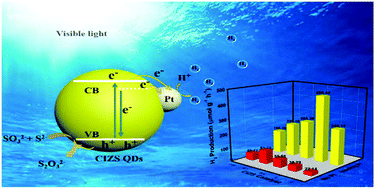当前位置:
X-MOL 学术
›
Inorg. Chem. Front.
›
论文详情
Our official English website, www.x-mol.net, welcomes your feedback! (Note: you will need to create a separate account there.)
Effective bandgap narrowing of Cu–In–Zn–S quantum dots for photocatalytic H2 production via cocatalyst-alleviated charge recombination
Inorganic Chemistry Frontiers ( IF 7 ) Pub Date : 2017-11-09 00:00:00 , DOI: 10.1039/c7qi00607a Lili Tan 1, 2, 3, 4 , Yanhong Liu 1, 2, 3, 4 , Baodong Mao 1, 2, 3, 4 , Bifu Luo 1, 2, 3, 4 , Guan Gong 1, 2, 3, 4 , Yuanzhi Hong 2, 4, 5, 6 , Biyi Chen 1, 2, 3, 4 , Weidong Shi 1, 2, 3, 4
Inorganic Chemistry Frontiers ( IF 7 ) Pub Date : 2017-11-09 00:00:00 , DOI: 10.1039/c7qi00607a Lili Tan 1, 2, 3, 4 , Yanhong Liu 1, 2, 3, 4 , Baodong Mao 1, 2, 3, 4 , Bifu Luo 1, 2, 3, 4 , Guan Gong 1, 2, 3, 4 , Yuanzhi Hong 2, 4, 5, 6 , Biyi Chen 1, 2, 3, 4 , Weidong Shi 1, 2, 3, 4
Affiliation

|
The development of single-component photocatalysts with narrow bandgaps (2.0–3.0 eV) has been one of the most important goals for photocatalytic H2 production, for which I–III–VI multinary sulfides play an important role due to their widely tunable composition-dependent bandgap. However, simultaneous bandgap narrowing and photocatalytic activity enhancement in the I–III–VI sulfides are often difficult to achieve due to increased defect states. Here, a series of Cu–In–Zn–S quantum dots (QDs) were synthesized by a facile hydrothermal method focusing on a more profound understanding of bandgap tuning and the subsequent effect on the photocatalytic process by controlling the Cu content. The bandgap of the QDs can be effectively tuned from 2.90 eV to 1.98 eV with an increasing Cu : In ratio from 0.05 : 10 to 2.5 : 10 and a color change from light yellow to dark red. The QDs show photocatalytic H2 production activity even without any cocatalyst, but it quickly starts to decrease with the Cu/In ratio over 0.1 : 10 (bandgap of 2.59 eV), which highly limits the potential for visible light photocatalysis. Interestingly, Pt-loading effectively enhanced not only the tolerance of Cu incorporation, but also enabled a high H2 production activity even with further bandgap narrowing down to ∼2 eV. The best photocatalytic performance of 456.4 μmol h−1 g−1 was achieved for the Cu : In : Zn ratio of 1 : 10 : 5 with a bandgap of 2.27 eV. This increased tolerance of Cu content may result from a combined effect of charge separation by Pt as the cocatalyst that alleviated the Cu-induced charge recombination. The enhanced charge separation was proved by the photoluminescence quenching of the QDs with the cocatalyst. Electrochemical impedance spectroscopy was further used to study the charge separation properties of this photocatalytic system. This is the first observation of the cocatalyst-enhanced tolerance of Cu resulting from the competition of cocatalyst-induced charge separation and defect-induced charge recombination in multinary sulfides, which provides an interesting view and design guideline for the development of narrow bandgap photocatalysts.
中文翻译:

通过助催化剂减轻的电荷复合作用, 有效地缩小Cu-In-Zn-S量子点的能带隙,以光催化生产H 2
具有窄带隙(2.0–3.0 eV)的单组分光催化剂的开发一直是光催化生产H 2的最重要目标之一,其中I – III – VI多元硫化物由于其可广泛调节的组成而起着重要的作用-依赖带隙。但是,在I – III – VI中同时带隙变窄和光催化活性增强由于缺陷状态增加,通常难以获得硫化物。在这里,通过简便的水热方法合成了一系列的Cu-In-Zn-S量子点(QD),其重点是对带隙调谐的更深刻理解,以及随后通过控制Cu含量对光催化过程的影响。可以将QD的带隙有效地从2.90 eV调整为1.98 eV,同时Cu:In的比例从0.05:10增加到2.5:10,颜色从浅黄色变为深红色。量子点显示出光催化的H 2即使没有任何助催化剂,其生产活动也很快,但是当Cu / In比率超过0.1:10(带隙为2.59 eV)时,其活性迅速开始下降,这极大地限制了可见光光催化的潜力。有趣的是,Pt负载不仅有效地提高了Cu掺入的耐受性,而且即使带隙进一步缩小到了约2 eV ,也实现了高H 2的生产活性。最佳光催化性能为456.4μmolh -1 g -1当Cu:In:Zn的比例为1:10:5且带隙为2.27 eV时,可实现λ/λ。铜含量的这种增加的耐受性可以归因于通过Pt作为助催化剂的电荷分离的联合作用,其减轻了Cu诱导的电荷复合。通过用助催化剂对量子点进行光致发光猝灭证明了电荷分离的增强。电化学阻抗谱进一步用于研究该光催化系统的电荷分离特性。这是对多元硫化物中助催化剂诱导的电荷分离和缺陷诱导的电荷重组竞争的结果,是对铜助催化剂增强铜耐受性的首次观察,这为窄带隙光催化剂的开发提供了有趣的观点和设计指南。
更新日期:2017-11-09
中文翻译:

通过助催化剂减轻的电荷复合作用, 有效地缩小Cu-In-Zn-S量子点的能带隙,以光催化生产H 2
具有窄带隙(2.0–3.0 eV)的单组分光催化剂的开发一直是光催化生产H 2的最重要目标之一,其中I – III – VI多元硫化物由于其可广泛调节的组成而起着重要的作用-依赖带隙。但是,在I – III – VI中同时带隙变窄和光催化活性增强由于缺陷状态增加,通常难以获得硫化物。在这里,通过简便的水热方法合成了一系列的Cu-In-Zn-S量子点(QD),其重点是对带隙调谐的更深刻理解,以及随后通过控制Cu含量对光催化过程的影响。可以将QD的带隙有效地从2.90 eV调整为1.98 eV,同时Cu:In的比例从0.05:10增加到2.5:10,颜色从浅黄色变为深红色。量子点显示出光催化的H 2即使没有任何助催化剂,其生产活动也很快,但是当Cu / In比率超过0.1:10(带隙为2.59 eV)时,其活性迅速开始下降,这极大地限制了可见光光催化的潜力。有趣的是,Pt负载不仅有效地提高了Cu掺入的耐受性,而且即使带隙进一步缩小到了约2 eV ,也实现了高H 2的生产活性。最佳光催化性能为456.4μmolh -1 g -1当Cu:In:Zn的比例为1:10:5且带隙为2.27 eV时,可实现λ/λ。铜含量的这种增加的耐受性可以归因于通过Pt作为助催化剂的电荷分离的联合作用,其减轻了Cu诱导的电荷复合。通过用助催化剂对量子点进行光致发光猝灭证明了电荷分离的增强。电化学阻抗谱进一步用于研究该光催化系统的电荷分离特性。这是对多元硫化物中助催化剂诱导的电荷分离和缺陷诱导的电荷重组竞争的结果,是对铜助催化剂增强铜耐受性的首次观察,这为窄带隙光催化剂的开发提供了有趣的观点和设计指南。

































 京公网安备 11010802027423号
京公网安备 11010802027423号